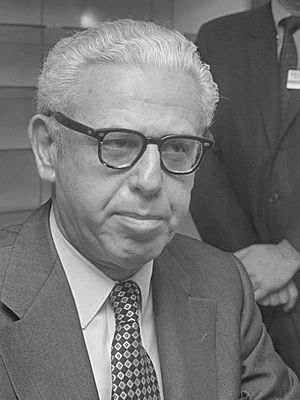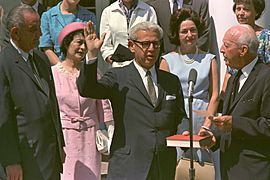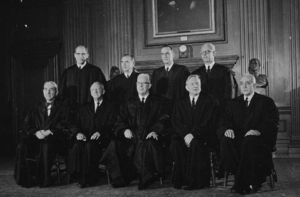Arthur Goldberg facts for kids
Quick facts for kids
Arthur Goldberg
|
|
|---|---|

Goldberg in 1971
|
|
| 6th United States Ambassador to the United Nations |
|
| In office July 28, 1965 – June 24, 1968 |
|
| President | Lyndon B. Johnson |
| Preceded by | Adlai Stevenson II |
| Succeeded by | George Ball |
| Associate Justice of the Supreme Court of the United States |
|
| In office October 1, 1962 – July 25, 1965 |
|
| Nominated by | John F. Kennedy |
| Preceded by | Felix Frankfurter |
| Succeeded by | Abe Fortas |
| 9th United States Secretary of Labor | |
| In office January 21, 1961 – September 20, 1962 |
|
| President | John F. Kennedy |
| Preceded by | James P. Mitchell |
| Succeeded by | W. Willard Wirtz |
| Personal details | |
| Born |
Arthur Joseph Goldberg
August 8, 1908 Chicago, Illinois, U.S. |
| Died | January 19, 1990 (aged 81) Washington, D.C., U.S. |
| Political party | Democratic |
| Spouse |
Dorothy Kurgans
(m. 1931; died 1988) |
| Children | 2 |
| Relatives | Barry Goldberg (nephew) |
| Education | |
| Awards | Presidential Medal of Freedom (1978) |
| Military service | |
| Allegiance | United States of America |
| Branch/service | United States Army |
| Rank | Major |
| Unit | Office of Strategic Services |
| Battles/wars | World War II |
Arthur Joseph Goldberg (August 8, 1908 – January 19, 1990) was an important American leader and judge. He held several big jobs in the U.S. government. He was the country's top labor official, the United States Secretary of Labor. He also served as a judge on the Supreme Court, which is the highest court in the U.S. Later, he became the U.S. Ambassador to the United Nations, working with countries around the world.
Arthur Goldberg was born in Chicago, Illinois, in 1908. He became a lawyer after studying at Northwestern University. He was known for helping workers and unions. During World War II, he worked for a special intelligence group. In 1961, President John F. Kennedy chose him to be the Secretary of Labor.
A year later, in 1962, President Kennedy nominated Goldberg to be a Supreme Court Justice. He was known for his liberal views and for writing important legal opinions. In 1965, he left the Supreme Court to become the U.S. Ambassador to the United Nations. In this role, he helped create a key resolution after the Six-Day War. He later ran for governor of New York but did not win. Arthur Goldberg passed away in 1990.
Contents
Arthur Goldberg's Early Life
Arthur Goldberg was the youngest of eight children. His parents were Jewish immigrants from the Russian Empire. They lived on the West Side, Chicago. His father, who sold produce, died when Arthur was young. This meant his older brothers and sisters had to leave school to help the family. Because he was the youngest, Arthur could stay in school. He worked jobs like selling things at Wrigley Field and working in a library to help his family.
He learned a lot at Hull House, a place that helped new immigrants. He finished Harrison Technical High School when he was 16. Arthur became interested in law after watching a famous murder trial in 1924. He saw how rich people could get better legal help. This made him believe that everyone, no matter how rich or poor, should be treated fairly by the law. He also looked up to other Jewish Supreme Court Justices like Louis Brandeis.
Arthur worked hard, even as a construction worker at night. He went to night classes at Crane Junior College and DePaul University. He then went to Northwestern University, where he earned two law degrees very quickly. He finished law school in just two and a half years! He was so good that he had the best grades ever at Northwestern. He was only 21, too young to be a lawyer in Illinois. But he went to court and successfully argued his own case to be allowed to practice law.
In 1931, Arthur married Dorothy Kurgans. They had two children, Barbara and Robert. His nephew, Barry Goldberg, became a famous musician.
Serving in World War II
During World War II, Arthur Goldberg joined the United States Army. He became a captain and then a major. He wanted to join the Marines, but he wasn't strong enough. He also worked for a secret group called the Office of Strategic Services (OSS). This group was like an early version of the CIA.
In the OSS, Goldberg led a special team called the Labor Desk. His job was to connect with workers and labor groups in Europe. He helped organize these groups to resist Nazi Germany. He created a large network of anti-Nazi transportation workers. This helped the American intelligence efforts during the war.
Helping Workers and Unions
Because of unfair treatment against Jewish people at the time, Goldberg could not work at the biggest law firms in Chicago. So, he started his career at a firm founded by German Jews. But he didn't like only representing big businesses.
His interest in helping workers grew during The Great Depression. In 1933, he started his own law firm to focus on labor law. He joined a group called the National Lawyers Guild that supported President Roosevelt's "New Deal" programs. However, he later left that group because it became too involved with the American Communist Party.
Goldberg became a very important labor lawyer. In 1938, he represented striking newspaper workers in Chicago. He spent many days in court fighting for their rights. Eventually, the strike helped the workers' union get recognized. In 1948, he became the main lawyer for the Congress of Industrial Organizations (CIO). He helped bring the CIO and the American Federation of Labor together in 1955. This created the AFL-CIO, one of the largest worker unions in the U.S. He also worked as the main lawyer for the United Steelworkers of America.
Arthur Goldberg's Political Career
Arthur Goldberg was very active in politics. He supported the presidential campaigns of Franklin D. Roosevelt and Harry Truman. He first supported Senator Joseph McCarthy's investigations into communism. But he soon changed his mind when he saw that these investigations were hurting labor unions.
In 1960, Goldberg supported John F. Kennedy for president. He advised Kennedy on labor issues and helped convince unions to support Kennedy's campaign.
Working for President Kennedy
President John F. Kennedy chose Arthur Goldberg to be the United States Secretary of Labor. He served in this role from 1961 to 1962. He was the third Jewish person to be part of a U.S. President's Cabinet. Goldberg wanted to be the Attorney General, but that job went to Kennedy's brother, Robert.
As Labor Secretary, Goldberg advised Kennedy to raise the minimum wage and extend unemployment benefits. He also suggested creating more job opportunities for young people and investing in areas that needed economic help. Following his advice, Kennedy created a committee to make sure employees were treated fairly, no matter their "race, creed, color, or national origin." Goldberg also pushed for a committee to advise on labor and management issues.
Serving on the Supreme Court
On August 31, 1962, President Kennedy nominated Goldberg to be a justice on the U.S. Supreme Court. He took the place of Justice Felix Frankfurter, who was retiring. Both Frankfurter and Chief Justice Earl Warren supported Goldberg's nomination.
The U.S. Senate approved his nomination on September 25. He served on the Court from October 1, 1962, to July 25, 1965. Only one Senator voted against him. During his time, the seat he held was sometimes called the "Jewish seat." This was because the two justices before him, Frankfurter and Benjamin Cardozo, were also Jewish. As of 2022, Goldberg is the last person to have served in a President's Cabinet and also on the Supreme Court.
Even though he was on the Court for a short time, Goldberg made a big impact. He had liberal views on the Constitution. This helped shift the Court's focus towards protecting more constitutional rights. He believed in "judicial activism," meaning judges should actively protect rights. He voted for liberal outcomes in most of the cases he heard.
One of his most famous opinions was in the case of Griswold v. Connecticut (1965). He argued that the Ninth Amendment supported a hidden "right of privacy." He said that to decide if a right is fundamental, the Court should see if denying it would go against the basic ideas of liberty and justice in America.
Goldberg also had a strong opinion about the punishment of death. In 1963, he wrote that using the punishment of death was wrong and should be seen as "cruel and unusual punishment." This goes against the Eighth Amendment.
His strong opinion encouraged lawyers across the country to challenge the fairness of the punishment of death. Because of many new appeals, the punishment of death was mostly stopped in the U.S. during the late 1960s and 1970s. The Supreme Court looked at this issue again in 1972 in the case of Furman v. Georgia. In that case, the justices decided to temporarily stop the punishment of death laws in many states. This was because the punishment was being applied unfairly. Later, in Gregg v. Georgia (1976), the justices allowed the punishment of death again under certain rules. A writer for The New York Times said that Goldberg's opinion helped start the modern movement to end the punishment of death.
Goldberg also wrote the main opinions in other important cases. In Escobedo v. Illinois, he said that people accused of crimes have the right to a lawyer during questioning. In Kennedy v. Mendoza-Martinez, he ruled that parts of a law that took away citizenship from people who avoided the draft were unconstitutional.
Many of Goldberg's law clerks (people who help judges with their work) became very influential. Stephen Breyer, who was one of Goldberg's clerks, later became a Supreme Court Justice himself. Another clerk was the famous Harvard law professor Alan Dershowitz. Goldberg made sure to hire Jewish clerks, as other justices might not have. Six out of his eight law clerks were Jewish.
Ambassador to the United Nations

In 1965, President Lyndon B. Johnson convinced Goldberg to leave his Supreme Court job. Johnson wanted Goldberg to become the U.S. Ambassador to the United Nations (UN). Johnson wanted to appoint his friend, Abe Fortas, to the Supreme Court. Johnson promised Goldberg that he would be part of the President's Cabinet and help make decisions about ending the Vietnam War.
Goldberg wrote that he left the Court to help bring peace in Vietnam. He hoped that after the war, Johnson would reappoint him to the Supreme Court as Chief Justice. He later said, "I thought I could persuade Johnson that we were fighting the wrong war in the wrong place [and] to get out."
Some people found it hard to believe why Goldberg left such an important job. His biographer suggested that Johnson might have had some influence over Goldberg.
As UN Ambassador, Goldberg successfully helped make peace between Greece and Turkey during a crisis in 1967. He also helped solve a conflict between North Korea and the United States after the 1968 Pueblo incident.
Helping with Resolution 242
In 1967, Goldberg was a key person in writing Resolution 242. This resolution came after the 1967 Six-Day War between Israel and the Arab states. Goldberg made it clear that the resolution did not mean Israel had to give up all the territories it had captured.
Later Career
Goldberg was unhappy with the Vietnam War. So, he resigned from his UN ambassadorship in 1968. He then joined a law firm in New York. He still wanted to be a judge. He later said that Chief Justice Earl Warren wanted him to be his replacement when Warren retired in 1968. But President Johnson chose Abe Fortas instead. After Fortas's nomination failed, Johnson thought about making Goldberg Chief Justice temporarily, but decided against it. In 1969, Goldberg spoke at a large protest against the Vietnam War.
Since Richard Nixon was elected president, Goldberg knew he couldn't return to the Supreme Court. So, he decided to run for elected office. He chose to run against Nelson Rockefeller for Governor of New York in 1970. Even though he started strong, his campaign didn't do well. People called him a "carpetbagger" (someone who moves to a new area just to get elected). He also wasn't very good at campaigning and didn't know much about New York. Rockefeller won by a large number of votes. Goldberg once told a voter who wished he was still on the Court, "so do I, sometimes."
After his defeat, Goldberg went back to practicing law in Washington, D.C. He also became the President of the American Jewish Committee. In 1972, he returned to the Supreme Court, but this time as a lawyer. He represented a baseball player named Curt Flood. One person said his argument was "one of the worst arguments I'd ever heard – by one of the smartest men I've ever known..."
Under President Jimmy Carter, Goldberg served as the U.S. Ambassador to a conference on Human Rights in 1977. In 1978, he received the Presidential Medal of Freedom, a very high honor.
Arthur Goldberg died in 1990. As a former member of the U.S. Army, he was buried at Arlington National Cemetery in Virginia.
See also
 In Spanish: Arthur Goldberg para niños
In Spanish: Arthur Goldberg para niños
- Demographics of the Supreme Court of the United States
- John F. Kennedy Supreme Court candidates
- List of Jewish American jurists
- List of justices of the Supreme Court of the United States
- List of law clerks of the Supreme Court of the United States (Seat 2)
- List of United States Supreme Court justices by time in office
- United States Supreme Court cases during the Warren Court




